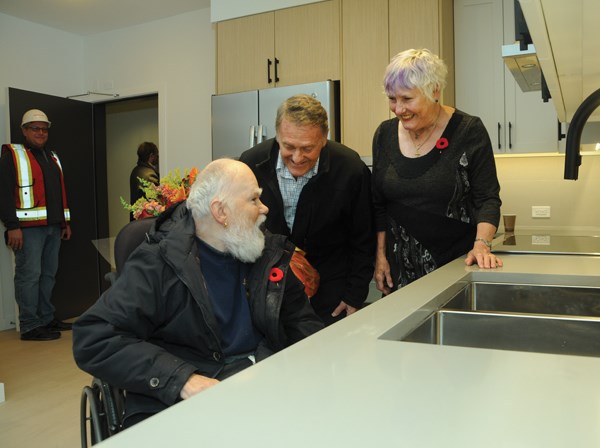It took four years but it yielded four new homes.
Marcon Developments recently cut the ribbon on a Mountain Highway development that includes four affordable, wheelchair-accessible apartments, operated by the North Shore Disability Resource Centre.
Despite purchasing the homes for $135,000 apiece, rent will be set at about $375, according to NSDRC executive director Liz Barnett.
“We’re making a contribution to housing people on the North Shore, but at a cost,” she said.
Barnett said they hope to raise funds to offset the yearly shortfall of $20,000.
NSDRC started working on the project in 2012 when the provincial government seemed poised to shut down one of their 11 group homes.
The organization was confronted with high rents and a dearth of options, particularly for tenants who need a layout that can accommodate a wheelchair.
“We already knew there was no place but now we’re faced with it,” Barnett recalled thinking.
Determined to help tenants remain in the community they’d called home for 30 years, NSDRC pledged to “build something.”
As community organizations entangle and entwine, the NSDRC found themselves in discussions with the Lynn Valley United Church.
Faced with an aged building and an older congregation, the church was searching for a way to remain in Lynn Valley.
“An easy course would’ve been to fold the tent ... and disappear from the Lynn Valley landscape into the annals of history, selling the land and building to the highest bidder,” said Doug Purdy when the project was first pitched.
Instead, the church floated plans to shrink its own footprint and finance a rebuild by allowing development of a four-storey, 75-unit apartment complex next door.
Barnett quickly realized their interests were “completely, 100 per cent aligned.”
Marcon eventually entered the fray.
After lobbying a sometimes “slow to respond” provincial government, Marcon proved refreshing and receptive, Barnett reported.
Marcon incorporated suggestions in the planning of the four accessible units, eventually settling on 539 square-foot apartments that include wheel-in showers, wall ovens, lowered countertops and accessible patios.
While Barnett is proud of the units, she’s also realistic about the problems facing renters with disabilities.
Out of the 1,400 calls NSDRC answered over the past year, Barnett estimates between 20 and 30 per cent of the callers wanted to talk about housing.
“Four units is nothing. It’s a drop in the bucket,” she says.
The four occupants of the Mill House must all be Canadian citizens with a recognized disability, according to Barnett.
The Mill House project divided District of North Vancouver council in 2014.
While there were concerns about long shadows falling on neighbours and a reduction of public assembly space, Mayor Richard Walton was ultimately swayed by the development’s proximity to Lynn Valley town centre.
“We’re changing a healthy place of worship to a healthy place of worship with a lot of additional housing on it,” he said.
The project includes a community amenity contribution of $455,000. Marcon also donated $75,000 to North Shore Rescue’s Tim Jones Legacy Fund.



